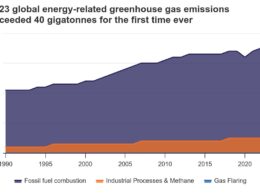According to a recent report, Australia’s fossil fuel exports contribute more to global emissions than any other country except Russia, largely due to the impact of coal exports. The report ‘Australia’s global fossil fuel carbon footprint’ by Climate Analytics projects a 50% increase in emissions over the next decade.
Australia’s climate footprint, accounting for roughly 4.5% of global fossil CO2 emissions—80% of which comes from coal and gas exports—“far exceeds” its economic size and population, according to the report. Without these fossil fuel exports, the country’s share of global emissions would be around 1%. Australia also has one of the highest per-capita greenhouse gas emissions, double that of China and nine times that of India, the world’s first and third-largest emitters, respectively.
In 2021, Australia was the third-largest fossil fuel exporter globally, behind only Russia and the US. In 2022, it was responsible for 52% of global metallurgical coal exports and 17% of global thermal coal exports.
Coal, the cheapest and dirtiest fossil fuel, is the largest single source of carbon emissions, contributing to over 0.3°C of the 1.2°C rise in global average temperatures since the Industrial Revolution and significantly impacting air pollution.
Between 2015 and 2020, Australia added 62 million tonnes of liquefied natural gas (LNG) capacity annually and has continued to approve large-scale projects into 2021 and 2022. By 2035, Australia’s fossil fuel exports are expected to add 15 billion tonnes to the cumulative CO2 emissions from its export sector since 1961, reaching a total of 45 billion tonnes.
At the COP28 summit last year, countries pledged to transition away from fossil fuels, the largest source of global greenhouse gas emissions. Despite this, global fossil fuel consumption has more than doubled over the past 50 years, driven by efforts to improve living standards and economic output. In 2023, the three main greenhouse gases—carbon dioxide (CO2), methane, and nitrous oxide—reached record levels.
The International Energy Agency (IEA) has called for a halt to new gas and oil field projects to maintain the 1.5°C net-zero emissions target. However, Australia’s current trajectory contradicts this advice.
“Australia has a responsibility not just to its own consumers of energy, but to the world,” the report read.
Climatologist Zeke Hausfather noted in April in a post on X (formerly Twitter) that “the ship has largely sailed on limiting warming to 1.5C at this point,” referencing recent data on the planet’s remaining carbon budget, which showed only 210 gigatonnes of CO2 remaining at the start of 2024. This budget represents the maximum amount of CO2 we can emit before surpassing our desired temperature increase limits.
The report indicates that Australia’s projected fossil fuel exports from now until 2035 will consume around 7.5% of the remaining carbon budget and about 9.1% of its total carbon footprint.





















